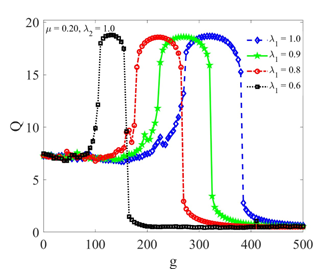Exploring vibrational resonance in biophysical systems with fractional-order damping
Keywords:
Vibrational Resonance, Biological System, Enzyme, Brain Wave, Differential EquationAbstract
Vibrational Resonance (VR), which is characterised by the enhancement of the maximum response of a weakly driven system’s output signal induced by a high-frequency (HF) periodic signal, was numerically examined in a bi-harmonically driven dimensionless model of an enzymesubstrate reaction with fractional-order damping, which models coherent oscillations in brain waves. The model incorporates a damping force that depends on a non-integer (fractional) order derivative rather than the typical first-order derivative in classical damping models. The output response was obtained by solving the model numerically using Grunwald-Letnikov’s fractional derivatives definition. The response amplitude,¨ computed from the Fourier spectrum of the output signal, was used to characterise VR. The effect of the fractional-order damping coefficient on the observed VR was considered for different damping strength coefficients. Single-peak resonances were observed. The fractional-order damping modulated the observed VR in a manner similar to the damping strength in an integer-order system, by reducing the high-frequency signal amplitude at which VR occurs. Increased brain wave activity from enzyme-substrate reaction may be due to inherent energy transfers from changes in the rate of decay, hence significant behavioural changes in brain wave activity could be linked to inherent changes in the decay rate of the excited enzymes, even when there is no change in the number of enzyme-substrate carriers. This study reveals the potential of fractional-order damping for enhancing biophysical system modelling, with implications for understanding brain wave activities.

Published
How to Cite
Issue
Section
Copyright (c) 2025 Kehinde A. Omoteso, Taiwo O. Roy-Layinde, Kayode O. Olonade, Hamid T. Oladunjoye, Babatunde A. Oyero, John A. Laoye

This work is licensed under a Creative Commons Attribution 4.0 International License.
How to Cite
Most read articles by the same author(s)
- B. J. Adekoya, B. O. Adebesin, V. U. Chukwuma, S. J. Adebiyi, S. O. Ikubanni, H. T. Oladunjoye, E. O. Adekoya, Pattern and variation of electron ionisation gradient as related to the plasma distribution mechanisms during the total solar eclipse of March 20, 2015 , Journal of the Nigerian Society of Physical Sciences: Volume 7, Issue 2, May 2025







